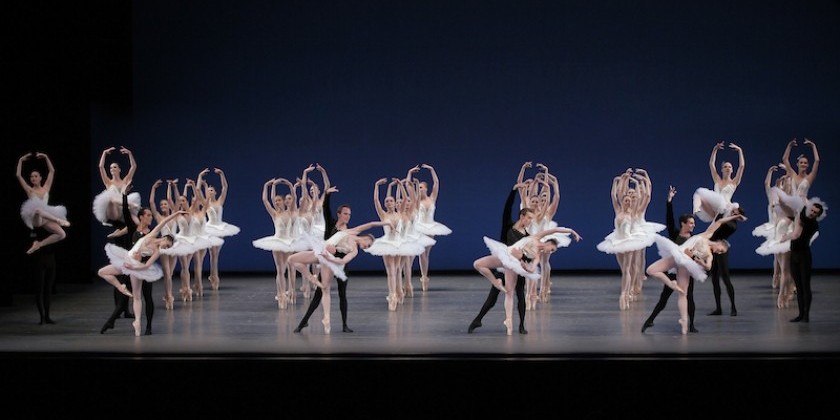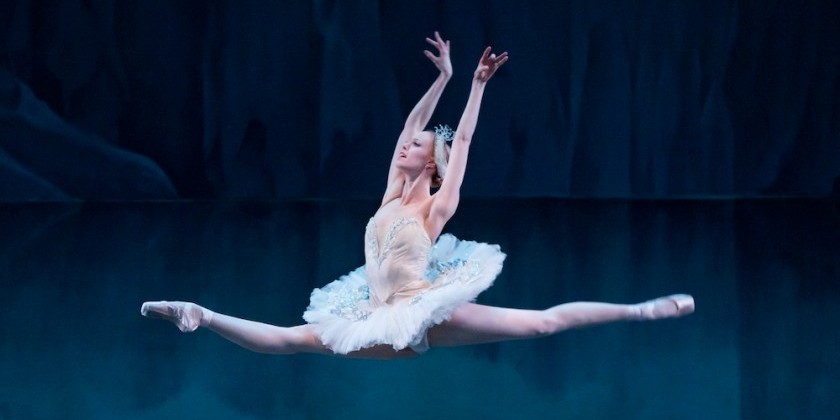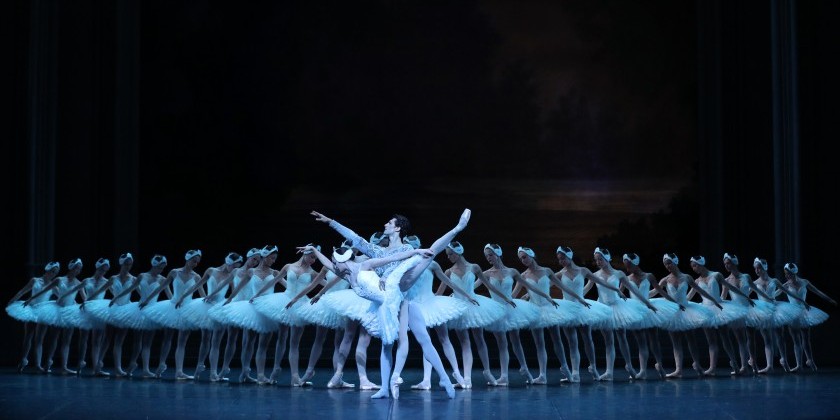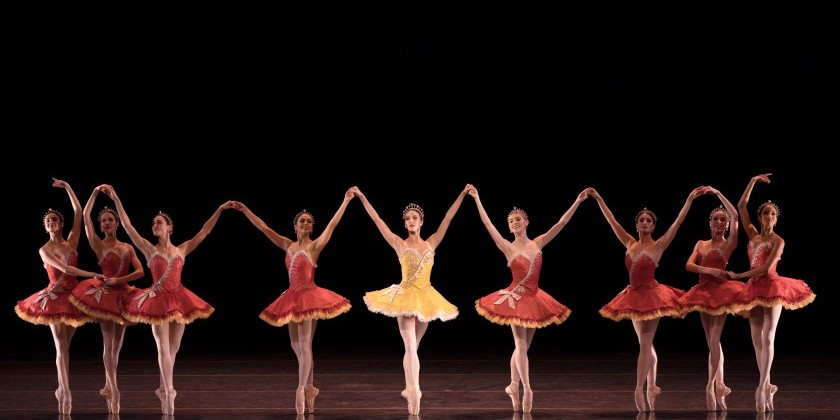IMPRESSIONS OF: New York City Ballet – Balanchine Black & White I and Hear the Dance: France

David H. Koch Theater, New York
May 2 and May 10, 2015
Photo above: Symphony in C, Choreography George Balanchine © The George Balanchine Trust, New York City Ballet
Speed. Attack. Skyscraper extensions. Precise footwork. These are well-known features of George Balanchine’s style. Fifteen years ago, though, many performances by the New York City Ballet, the company he founded in 1948, were characterized by speed without attack, legs that were high but imprecise. More generally, there was a sense that the masterpieces at the heart of the troupe’s repertoire had become misunderstood. Stripped of meaning, the works no longer moved; they became all style. This began to change a decade ago, when many of the current principals were in the corps. Today, the company is—thrillingly—in the midst of a full-fledged renaissance.
Just how well many Balanchine works are faring at NYCB was on abundant display during the first two weeks of the spring season, when it presented four all-Balanchine bills. I attended two of these. The first program featured five of his so-called “black-and-white ballets”—a nod to the dancers’ simple classroom attire. The oldest of the pieces, Concerto Barocco (1941), may be the most perfect marriage of music and dance in the history of ballet. Set to Bach’s Double Violin Concerto in D Minor, the work presents an idealized, almost heavenly, world of harmonious symmetries. In the first and third movements, eight corps women and two ballerinas, costumed in white, respond to Bach’s luminous score with crystalline steps and intricate patterns that embody the music with a rightness that seems as inevitable as the movement of the planets.

Concerto Barocco, Choreography: George Balanchine, © The George Balanchine Trust, New York City Ballet; Photo: Paul Kolnik
In the lead roles, Teresa Reichlen, dancing to the first violin, and Sara Mearns, dancing to the second, were well matched physically—both are tall dancers who move on a large scale—and their distinct dancing styles meshed well. Reichlen is a generous dancer, performing steps sensitively and with full value, but she tends toward restraint. Mearns, by contrast, approached her role by going for broke—her jumps were enormous and she used her torso, head, and arms so expansively that they seemed to fill the space and reach out to the highest balcony. Both dancers have gorgeous feet, an important asset in a dance where the foot is often presented in courtly forward walks and where the pointework is fast.
In the second, largo section, Reichlen, accompanied by a male partner (Justin Peck), dances with a creamy musicality that sings alongside the soaring cantilena of the violin solo. Particularly memorable are supported extensions in which her raised leg carves a circle in space from front to back; the arc of the circle seemed to expand and crest along with the cresting of the musical line. In the role’s signature diving arabesques, she lets her arms linger above her head, suspended, before the arabesques, which lends them the quality of a tender sigh. Peck is an attentive partner.
The last movement is the fastest and jazziest. This section, which looked soggy and anemic a few years ago, has regained its former vitality. The corps danced with a joyous attack alongside the principals.

The Four Temperaments (1946), which closed the Balanchine Black & White program, is completely different in tone from Barocco, and it too was danced with sharply focused vibrancy.
Balanchine commissioned The Four Temperaments’ score from Paul Hindemith during the Second World War; unsurprisingly, the music is at times dark, with Age of Anxiety undertones, though it ends on a triumphant note. The choreographer responded with a dance of menacing beauty unlike anything else in the ballet canon. A colleague once noted that it’s the work in which Balanchine came closest to modern dance—two male solos veer decidedly off the ballet grid into an expressionism that includes falls to the floor, and in one section, torsos crouch unclassically over the classical legwork. Amar Ramasar particularly stood out here in the Phlegmatic section. This solo is usually danced by a slighter, more flexible man for whom the dance’s motif of crumpling toward the floor comes more naturally. The strongly built Ramasar settled on suspenseful pauses between the turned-in jerks of his crumpling to give the effect of a collapse outside of his control. This was an unusual interpretation but it worked. Ashley Bouder, who has been having a phenomenal year, was a whirling dervish in the final, fierce Choleric section.
The second program I attended featured four ballets set to scores by French composers. The mixed bill opened with Walpurgisnacht Ballet (1980), choreographed to music from Gounod’s 1859 opera, Faust. Mearns has made this work her own over the past few years. Her legs unfold into high extensions that tilt dangerously off balance while her pointework is marked by large contrasts of scale and direction, all performed with a suspenseful musicality. As Gounod’s music builds from lilting to frenzied, her authoritative femininity becomes wildly Dionysian in multiple series of quick turns across the stage. She makes the lightning-fast traveling turns not only virtuosic but expressive; there is no doubt we are witnessing the balletic equivalent of a pagan revel.
The young corps dancer Alexa Maxwell made her debut in the sweetly girlish demi-soloist role of Walpurgisnacht earlier in the season. In this role, only her second soloist part since joining the company a year and a half ago, she displays confidence and a lovely pliancy of the torso along with a light jump. Maxwell’s attentiveness to fine details and her musical acuity give an impressive maturity to her dancing.

In La Valse (1951), set to that Ravel score as well as to his Valses Nobles et Sentimentales, Balanchine made an unusual foray into a romanticism tinged with fifties surrealism. The haunted ballroom atmosphere reminds me of the enchanted castle in Cocteau’s "Beauty and the Beast." The choreography initially emphasizes the dancers’ white-gloved hands, as though to prefigure the coming drama. In the first half, men pursue women who invariably elude them. This is a common Balanchine theme; the twist here is that the women might be phantoms.
Sterling Hyltin, playing the heroine who is tragically seduced by Death in the second half, brings a wonderful innocence and ecstasy to the role. When Death appears in the person of Ramasar, she is torn between fear and desire. As he offers her the long black gloves that will seal her fate, she buries her hands in them voraciously. Jared Angle, cast as the lover who loses her, is strikingly tender and ardent.

The exuberant Symphony in C (1947), a masterpiece of classicism, concluded the all-French program. Bouder led the first movement of the Georges Bizet score with dazzling ease and a mischievous sense of humor. One of the greatest joys of the dancing by many members of this generation of principal women is their striking musical alertness, which manifests itself differently from dancer to dancer. Bouder’s musicality is nearly always witty. She lingers over balances, for example, in a way that plays with the music and seems to dare it to outspeed her.
In the third and fourth movements, Erica Pereira and Brittany Pollack gave admirable performances, though Pereira needs stronger, clearer beats. Both were to my mind outshone by their male partners: Antonio Carmena in the third—flawless in a series of jumps and pirouettes ending in a double air turn—and Taylor Stanley in the fourth.
Only the second movement was disappointing. Balanchine responded to Bizet’s mournful oboe melody with an adagio that’s heart-catchingly beautiful when performed well. The dance is exceedingly difficult to master, as the ballerina must become a conduit for the music. The pull of the fluid stretch in her legato movements must be indistinguishable from the pulling quality of the music’s sustained notes. Maria Kowroski’s long, beautifully shaped legs are a pleasure to watch in the slow, arcing lifts that Balanchine once characterized as “the dance of the moon.” But she is not a musical dancer. She’s also an overly safe dancer, as she showed in the adagio's one unpartnered section. The choreography here isn't showy, but it can, and should, be exciting, not humdrum.
Dancing the same movements behind her, the corps—NYCB’s future—showed how the steps should be done.













